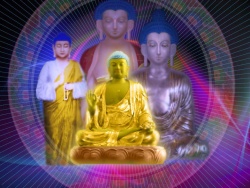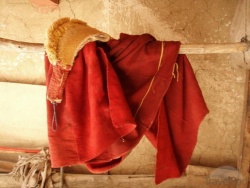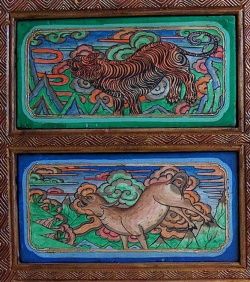Difference between revisions of "Smoking: different perspectives"
| (3 intermediate revisions by the same user not shown) | |||
| Line 25: | Line 25: | ||
^ an early Tibetan/Chinese pipe | ^ an early Tibetan/Chinese pipe | ||
| − | [[Hvashang]] | + | [[Hvashang]] [[Tibetan]] or [[Hotei]] {{Wiki|Chinese}} is a figure associated with {{Wiki|tobacco}}, in that his hempen or [[calico bag]] was said to contain that [[substance]]. Waters (1890's) in his [[discussion]] of the "[[18 Arhats]]" mentions that tobacconists kept his figure in their shop windows. |
| + | |||
| + | |||
Blocking the Channels | Blocking the Channels | ||
| + | |||
[[Monks and nuns]] and [[people]] working with what are known as the drops and [[winds]] of the [[subtle body]], besides not using {{Wiki|tobacco}} [[thinking]] that it might contradict the prohibition against using [[intoxicants]], also seem to [[feel]] that it hinders or creates blockages in the [[subtle channels]]. | [[Monks and nuns]] and [[people]] working with what are known as the drops and [[winds]] of the [[subtle body]], besides not using {{Wiki|tobacco}} [[thinking]] that it might contradict the prohibition against using [[intoxicants]], also seem to [[feel]] that it hinders or creates blockages in the [[subtle channels]]. | ||
| Line 38: | Line 41: | ||
From the [[Ratna Lingpa]] [[Vajrakilaya]] by [[Yangthang Rinpoche]] (translated by [[Sangye Khandro]], published by [[Yeshe Melong]] Pacific Region, [[Yeshe Nyingpo]] Media and Archives): | From the [[Ratna Lingpa]] [[Vajrakilaya]] by [[Yangthang Rinpoche]] (translated by [[Sangye Khandro]], published by [[Yeshe Melong]] Pacific Region, [[Yeshe Nyingpo]] Media and Archives): | ||
| − | "Another extremely important [[samaya]] | + | "Another extremely important [[samaya]] [[tantric]] {{Wiki|obligation}} or bond] is to totally abandon the [[smoking]] of cigarettes. According to [[Vajrayana]], cigarettes are considered to be a most negative [[substance]], and this is because the {{Wiki|tobacco}} was actually cursed by a [[Wikipedia:demon|demoness]] a long, long time in the {{Wiki|past}}. Wherever {{Wiki|tobacco}} is {{Wiki|present}} the [[Vajrayana]] cannot be propagated successfully. |
[[Vajrapani]], the holder of the [[secret mantra]], had a very strong [[aspiration]] to go into the land where the curse of {{Wiki|tobacco}} was in effect to propagate the [[secret mantra]]. He was unable to do so because of the presence of {{Wiki|tobacco}}, but later through his [[miraculous powers]], he was able to go in and [[gather]] up the {{Wiki|tobacco}} as best he could and take it beyond the farthest limits of the ocean. | [[Vajrapani]], the holder of the [[secret mantra]], had a very strong [[aspiration]] to go into the land where the curse of {{Wiki|tobacco}} was in effect to propagate the [[secret mantra]]. He was unable to do so because of the presence of {{Wiki|tobacco}}, but later through his [[miraculous powers]], he was able to go in and [[gather]] up the {{Wiki|tobacco}} as best he could and take it beyond the farthest limits of the ocean. | ||
Latest revision as of 14:06, 18 October 2015
</nomobile>
"With more deaths to its name than all the illicit narcotics put together, there can be no doubt that tobacco is the most dangerous drug in the world." The Encyclopedia of Psychoactive Substances.
However, there is no need to stop smoking before you devote yourself to practicing Buddhism. The general view is that if you "Start Where You Are," and try to apply principles such as Mindfulness, you will eventually stop doing negative actions.
History
The use of tobacco by smoking was not widely known outside the New World, where a very powerful form of it was primarily used for ceremonial purposes, until 1519 when Oviedo carried tobacco leaves back to Spain from Mexico.
Jean Nicot de Villmain introduced the plant now designated Nicotiana rustica to France in 1560. (Nicotiana is a family of plants and the small one with white scented flowers is a popular garden favorite.)
It is widely, but probably incorrectly, held, that it was Sir Walter Raleigh who introduced tobacco to the court of Elizabeth the First of England. It was first known as Petum, a Guarani (native American) word.
However, another kind of wild tobacco grew and was used by humans independently of the American one, in the "outback" of Australia. Captain Cook's 1770 expedition records show that Aborigines chewed it.
By 1924, there was no place that tobacco had not spread to, though its use was not necessarily by smoking. Snuff-taking as the most popular form of its use in the Asian countries for a long period of time.
In Tibet until very recently, users had a yak horn container adorned with silver, corals and turquoises to hold the powdered tobacco. It has a little bone spoon set in the stopper which is attached by a chain to the bottle.
There is no mention of it or any allusion to it, including proscriptions against using it, in Buddhist (or Hindu) writings until much later. Also, there is no word or phrase for it in the classical languages of India and Tibet, though of course now there is. There are prohibitions in some older texts against the use of "black stuff" but whether the phrase referred to hashish, opium, tobacco or even tea is not clear at all.
^ an early Tibetan/Chinese pipe
Hvashang Tibetan or Hotei Chinese is a figure associated with tobacco, in that his hempen or calico bag was said to contain that substance. Waters (1890's) in his discussion of the "18 Arhats" mentions that tobacconists kept his figure in their shop windows.
Blocking the Channels
Monks and nuns and people working with what are known as the drops and winds of the subtle body, besides not using tobacco thinking that it might contradict the prohibition against using intoxicants, also seem to feel that it hinders or creates blockages in the subtle channels.
On the other hand, some lamas do not appear to think its use is of major concern. Also, V.R. Burkhardt, writing about Chinese customs in the 1950s, remarked that some Buddhist nuns from Shanghai officiating at a funeral in T'ai Tam "smoked endless cigarettes."
It is estimated that 25% of Thai monks smoke.
Nevertheless, the predominant contemporary view follows:
From the Ratna Lingpa Vajrakilaya by Yangthang Rinpoche (translated by Sangye Khandro, published by Yeshe Melong Pacific Region, Yeshe Nyingpo Media and Archives):
"Another extremely important samaya tantric obligation or bond] is to totally abandon the smoking of cigarettes. According to Vajrayana, cigarettes are considered to be a most negative substance, and this is because the tobacco was actually cursed by a demoness a long, long time in the past. Wherever tobacco is present the Vajrayana cannot be propagated successfully.
Vajrapani, the holder of the secret mantra, had a very strong aspiration to go into the land where the curse of tobacco was in effect to propagate the secret mantra. He was unable to do so because of the presence of tobacco, but later through his miraculous powers, he was able to go in and gather up the tobacco as best he could and take it beyond the farthest limits of the ocean.
Unfortunately, some of it was still left behind and so it has continued to be and will be present in the world for a long, long time. It is an extremely negative substance. Even just the smell of it has the power to defile secret mantra substances such as images, scriptures, stupas, and so on. If any smoke from it is even around those things, the consecration within them will be ruined.
If someone else is smoking and that smoke happens to go into your mouth, both of you will take the lowest rebirth. Someone who partakes of tobacco will not be able to accomplish phowa, the transference of consciousness at the time of death and even someone attempting to do the phowa for such a person will not be successful because the channel will be blocked. You should understand that the use of tobacco must be eliminated from the root. These are also the words of the owner of secret mantra, Vajrapani himself."
~ posted to The Kagyu Mailing List by Jen
The work of paleo-anthropologist Johannes Wilbert is cited in the encyclopedia article linked at the foot of this page which further says "South American shamans believe that, whilst the human hunger is for food, the hunger of the spirits is for tobacco."
In tantrism "the view is more important than the written context, eg. eating meat and drinking alcohol at a Mahakala tsok [feast] on the surface appears to contradict the Buddha's example, but it is basically a representation of transformation of an obscuration [stain, or "sin"] to a virtue.
On my trip to Tibet, I met several rinpoches who were jailed during the cultural revolution in China. Not only had they been beaten to a pulp in their jail cells but also were forced to smoke [cigarettes]. I met one rinpoche who transformed this activity into practice instead of an indulgence -- an offering to wrathful deities in his daily practice."


